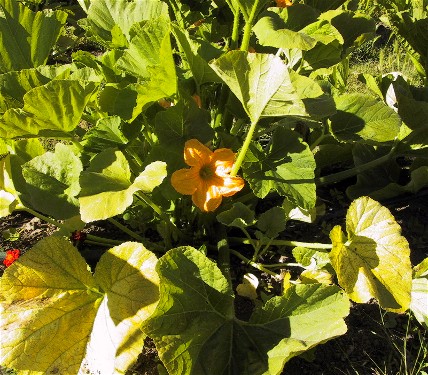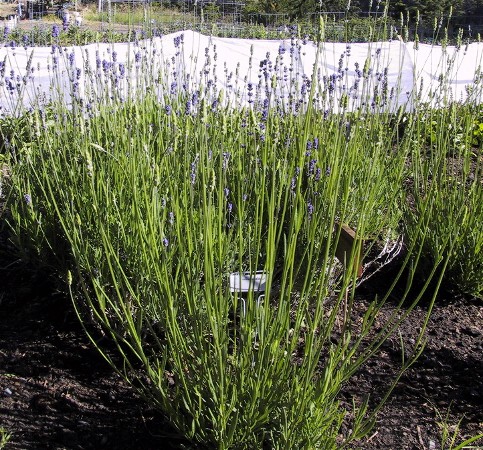

The Steering Committee met on the 19th, a fine July afternoon, under the cherry tree at the Garden. Present were Co-Chairs Tom Warnock and Mary Austin, plus Ken Holmes, Sally Skibbins, Jer Skibbins, Dianne Rasmussen, Ralph Rasmussen, Jim Grenwelge, John Horn, and your faithful scribe, Chester Case. Honored guest: Charles Shaw.
Decisions were reached, reports given, tasks assigned, and perennial perplexities pondered. Progress in aligning gardening intentions with gardening outcomes was noted as Ken laid out current planting plans. He is doing a super job, which ain’t so easy because of the unpredictable variables, including the meeting of gardening minds. Mid-summer we will plant beets, carrots and turnips from seed and, from our ever-productive greenhouse, bulb fennel, parsley, cabbage, kohlrabi, chard and cilantro. Say, give yourself a treat and mosey up and down the beds, check all that is ready to pick, nearing readiness, and all that is coming along nicely, like the squashes and pumpkins. Sorry, no corn, eggplant, potatoes...they just won’t produce here.
Decision: major work party on Thursday, July 31, 2003. 10:00-1:00, followed by lunch. This time of year, a lot of clean-up and deferred work needs attention, so how about a work party and an al fresco lunch afterward? Yes. Master cooker Jim Grenwelge will bring his patented grill and whomp up the main course and generally coordinate the eats. Day Leaders will get a count of who can come, and tell their days what they are to bring to share. Bring gloves and beverage.
Construction will begin on the Doris Buck Memorial using the donations received to date. About half of the necessary funds have been contributed. Day leaders will invite donations again. Mary Austin will glean previous rosters for potential contributors and contact them. Tom and Ken will email Gardeners.
The time has arrived for the Garden to put in writing its organization, practices and policies. Tom distributed a preliminary concept paper on organization and asked Steering Committee members to critique it for discussion at the next meeting.
Before the meeting adjourned, Jer Skibbins observed, “There are meetings and meetings going on all over the Sea Ranch, and of them, this is the most productive; it has to do with growing.” Right on.

· Big Red, the rebuilt Troy-Bilt rototiller, has sprung a transmission seal. It will be out of service for a while. Meanwhile, the Skibbins’ Mantis will join the Mantis on hand for light tilling chores.
· High tech arrives in the form of a moisture-detecting device that Tom and others have been trying out. It gives a reading on a dial of the moisture level down by the roots. More accurate, faster and easier to use than the core-sampling probe. The Garden will purchase several and incorporate them into the watering routines.
· Take care! Dianne Rasmussen and her crew have planted beneficial flowers in the beds...only some have been “weeded” out by too-efficient Gardeners.
· Help Wanted, Still: Replacement needed at the Treasurer’s post. Easy work, short hours, pleasant surroundings, no pay. See Tom or Mary if you are interested. The job is mostly paying the few bills the Garden incurs, receiving the dues and preparing the annual roster, making deposits, and keeping some records.
· No new news on our negotiations with the Baker Estate, Tom reported.
· Doris Buck Memorial Trellis construction will start soon. If you are interested in helping build it, contact Ben Klagenberg. Donations welcome (and needed). Make out your check to Posh Squash and note “Doris Buck Memorial Trellis” on it.

In the next few weeks, our herbalist Dianne Rasmussen plans to harvest the "grosso" lavender in herb bed H1. She will hang it in the shed to dry, and says there will be bouquets for everyone at that time. May we all enjoy their splendid scent in our homes as well as in the garden!
Garden HaikuLupine leaf clusters Minute dew drops Tiffany brooches! Gerry Wilson |

Sue Blair called TCH’s
attention to Jack Hitt, “A Gospel According to the Earth:
Sown by science a new eco-faith takes root,” Atlantic
Monthly, July 2003. We found it thought- provoking, very
well-written, and distinctly related to our one acre of Garden.
We asked Sue to review and comment on it, a daunting task as we
gave her only 350-400 words and the article is long,
many-layered, learned, rich in allusion...and thronging with
invitations to discuss and debate. She does admirably. Plus, Sue
will give you a copy of the article if you ask her.
In recent years, communal gardens have
achieved an astounding popularity with millions of adults and
children. This phenomenon is clearly part of growing
environmental awareness. Jack Hitt suggests it may be more than
that, and notes the commonality among composting, recycling,
consumption of organic foods, and contemporary and past religious
practices. Did you know that “compost” and
“communion” have similar Latin roots? Both mean a
sharing or putting together.
The author shows how science and religion
meet in the “environmental movement,” a term first used
as recently as 1972! Ranging further afield, Hitt evidences his
concern for words. Taking “the word” literally can have
devastating results, from what happens when you plant directly
into compost to what happens when one insists that a literal
interpretation of scripture is the only valid interpretation. We
are, according to Hitt, “more bound up than ever in a fight
that dates back to the Enlightenment.” Environmentalism may
be a “new scaffolding for knowing things and creating
values.”
“Three centuries of reason have taught
us that we are not under God’s special protection, though we
are very much a part of something larger than ourselves that we
don’t really understand. We fear the effects of our own
collective hand every time we turn on the TV and see the coast of
Florida festooned with dead whales or that tanker sink beneath
the swells off Spain taking with it 20 million gallons of crude
to leach out into the deep blue sea for the next two
centuries...These stories feel like sin.”
“We live in end times, all right. But
it’s not the end of the world that’s coming; it’s
the declining power of the sacred word to reach our hearts as
something other than shibboleth. Elsewhere new words appear in
the culture and assume a subtle power, one that begins to feel
like truth. For now, we might not be able to hear the fullness of
their meanings or foresee the ripe possibilities of their future
connotations. Compost. Global warming. Off the grid.
Pollution. Renewable. Tree-sitting.”
Perhaps these words will take on metaphorical
meanings, but for now...here’s to joyful participation in
the wonders of the garden.
(Ed. By the way, author Hitt did
plant tomatoes in pure compost, and what happened he relates as a
parable: they grew fast, tall, as if deranged, blossomed,
fructified...and the tomatoes literally exploded).

What’s that weird little veggie that looks like Sputnik? Got an above-ground bulb about the size of a golf ball? Strong stems emerge amusingly from the bulb and rise to a crown of greens?
Well, meet the KOHLRABI. If all goes well, there are going to be plenty of kohlrabis for the Gardeners. Hundreds (well, almost) are growing in the raised bed by the Greenhouse. Here is what Sharon Tyler Herbst says about the kohlrabi in Food Lover’s Companion:
“Kohlrabi is a member of the turnip family and, for that reason, is called cabbage turnip. Like the turnip, both its purple-tinged, white bulblike stem and its greens are edible. The kohlrabi bulb tastes like a mild sweet turnip...Those under 3 inches in diameter are the most tender. Choose a kohlrabi that is heavy for it size with firm, deeply colored green leaves...Store tightly wrapped up to 4 days in the refrigerator. Kohrabi’s best steamed, but can be added to soups and stews as well as used in stir-fries. It’s rich in potassium and vitamin C.”
Kohlrabi is a member of the brassica family (so is the turnip). Like other brassicas, it has been specialized – "grotesqued,” the actual term -- by centuries of selective breeding. Steve Solomon tells in Growing Vegetables West of the Cascades, page 274, how the essential brassica has been diversified:
“Terminal buds can be wildly exaggerated into heads of cabbage, axial buds can be swollen into Brussels sprouts, small flower clusters can become giant broccoli and cauliflower, petioles can be elongated into celerylike stalks as found in fancy mustards, stems can be thickened into rutabaga and kohlrabi, and roots can be fattened into turnips and radishes”.
Some Gardeners may not have cooked with kohlrabi, but others are already fans. Mary Alinder uses it like jicama: Peel, slice and put in salads. Jim Grenwelge steams kohlrabi like turnips and thinks highly of the greens. Reva Basch cooks it like her German mother used to: Peel, slice like potatos, sautee with some sliced onions in bacon fat (sure…) or oil, season with a dusting of celery seed, salt and white pepper to taste.
In the next issue of The Compost Heap: MEET THE TOMATILLO
